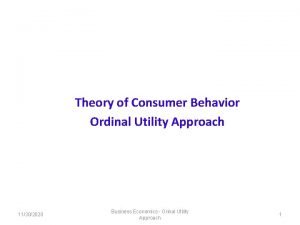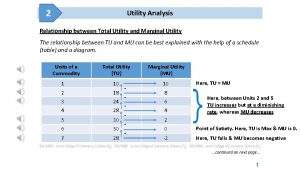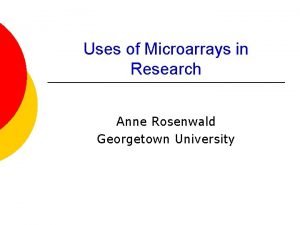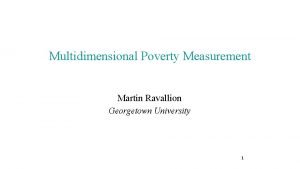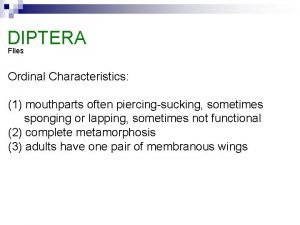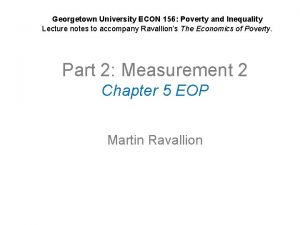Utility Molly W Dahl Georgetown University Econ 101










































- Slides: 42

Utility Molly W. Dahl Georgetown University Econ 101 – Spring 2009 1

Utility Functions A utility function U(x) represents a preference relation f if and only if: ~ p n x’ x” U(x’) > U(x”) x’ p x” U(x’) < U(x”) x’ ~ x” U(x’) = U(x”). 2

Utility Functions Utility is an ordinal concept. n E. g. if U(x) = 6 and U(y) = 2 then bundle x is strictly preferred to bundle y. But x is not preferred three times as much as is y. n ¨ The magnitude of the difference does not matter, only the order. 3

Utility Functions & Indifference Curves Consider the bundles (4, 1), (2, 3) and (2, 2). n Suppose (2, 3) (4, 1) ~ (2, 2). n Assign to these bundles any numbers that preserve the preference ordering; e. g. U(2, 3) = 6 > U(4, 1) = U(2, 2) = 4. n Call these numbers utility levels. n p 4

Utility Functions & Indifference Curves n An indifference curve contains equally preferred bundles. Equal preference same utility level. n Therefore, all bundles in an indifference curve have the same utility level. n 5

Utility Functions & Indifference Curves So the bundles (4, 1) and (2, 2) are in the indiff. curve with utility level U º 4 n But the bundle (2, 3) is in the indiff. curve with utility level U º 6. n On an indifference curve diagram, this preference information looks as follows: n 6

Utility Functions & Indifference Curves p x 2 (2, 3) (2, 2) ~ (4, 1) Uº 6 Uº 4 x 1 7

Utility Functions & Indifference Curves x 2 Uº 6 Uº 4 Uº 2 x 1 8

Utility Functions & Indifference Curves Comparing all possible consumption bundles gives the complete collection of the consumer’s indifference curves, each with its assigned utility level. n This complete collection of indifference curves completely represents the consumer’s preferences. n 9

Utility Functions & Indifference Curves The collection of all indifference curves for a given preference relation is an indifference map. n An indifference map is equivalent to a utility function; each is the other. n 10

Utility Functions There is no unique utility function representation of a preference relation. n Suppose U(x 1, x 2) = x 1 x 2 represents a preference relation. n Again consider the bundles (4, 1), (2, 3) and (2, 2). n 11

Utility Functions U(x 1, x 2) = x 1 x 2, so U(2, 3) = 6 > U(4, 1) = U(2, 2) = 4; that is, (2, 3) p n (4, 1) ~ (2, 2). 12

Utility Functions (2, 3) p U(x 1, x 2) = x 1 x 2 n Define V = U 2. n (4, 1) ~ (2, 2). 13

Utility Functions U(x 1, x 2) = x 1 x 2 (2, 3) (4, 1) ~ (2, 2). n Define V = U 2. n Then V(x 1, x 2) = x 12 x 22 and V(2, 3) = 36 > V(4, 1) = V(2, 2) = 16 so again (2, 3) (4, 1) ~ (2, 2). n V preserves the same order as U and so represents the same preferences. p n p 14

Utility Functions p U(x 1, x 2) = x 1 x 2 (2, 3) n Define W = 2 U + 10. n (4, 1) ~ (2, 2). 15

Utility Functions U(x 1, x 2) = x 1 x 2 (2, 3) (4, 1) ~ (2, 2). n Define W = 2 U + 10. n Then W(x 1, x 2) = 2 x 1 x 2+10 so W(2, 3) = 22 > W(4, 1) = W(2, 2) = 18. Again, (2, 3) (4, 1) ~ (2, 2). n W preserves the same order as U and V and so represents the same preferences. p n p 16

Utility Functions If ¨U is a utility function that represents a preference relation f and ~ ¨ f is a strictly increasing function, Then V = f(U) is also a utility function representing f. ~ ¨ That is, utility functions are unique up to a monotone transformation 17

Some Other Utility Functions and Their Indifference Curves n Consider V(x 1, x 2) = x 1 + x 2. What do the indifference curves for this utility function look like? (note: only the total amount of the two commodities determines the utility) 18

Perfect Substitutes x 2 x 1 + x 2 = 5 13 x 1 + x 2 = 9 9 x 1 + x 2 = 13 5 V(x 1, x 2) = x 1 + x 2. 5 9 13 x 1 19

Perfect Substitutes x 2 x 1 + x 2 = 5 13 x 1 + x 2 = 9 9 x 1 + x 2 = 13 5 V(x 1, x 2) = x 1 + x 2. 5 9 13 x 1 All are linear and parallel. 20

Some Other Utility Functions and Their Indifference Curves n Consider W(x 1, x 2) = min{x 1, x 2}. What do the indifference curves for this utility function look like? (note: only the number of pairs matter) 21

Perfect Complements x 2 45 o W(x 1, x 2) = min{x 1, x 2} = 8 8 min{x 1, x 2} = 5 min{x 1, x 2} = 3 5 3 3 5 8 x 1 22

Perfect Complements x 2 8 5 3 45 o W(x 1, x 2) = min{x 1, x 2} = 8 min{x 1, x 2} = 5 min{x 1, x 2} = 3 3 5 8 x 1 All are right-angled with vertices on a ray from the origin. 23

Some Other Utility Functions and Their Indifference Curves n A utility function of the form U(x 1, x 2) = f(x 1) + x 2 is linear in just x 2 and is called quasilinear. n E. g. U(x 1, x 2) = 2 x 11/2 + x 2. 24

Quasi-linear Indifference Curves x 2 Each curve is a vertically shifted copy of the others. x 1 25

Some Other Utility Functions and Their Indifference Curves n Any utility function of the form U(x 1, x 2) = x 1 a x 2 b with a > 0 and b > 0 is called a Cobb. Douglas utility function. n E. g. U(x 1, x 2) = x 11/2 x 21/2 (a = b = 1/2) V(x 1, x 2) = x 1 x 23 (a = 1, b = 3) 26

Cobb-Douglas Indifference Curves x 2 All curves are hyperbolic, asymptoting to, but never touching any axis. x 1 27

Marginal Utilities Marginal means “incremental”. n The marginal utility of commodity i is the rate-of-change of total utility as the quantity of commodity i consumed changes; i. e. n 28

Marginal Utilities n E. g. if U(x 1, x 2) = x 11/2 x 22 then 29

Marginal Utilities n E. g. if U(x 1, x 2) = x 11/2 x 22 then 30

Marginal Utilities n So, if U(x 1, x 2) = x 11/2 x 22 then 31

Marginal Utilities and Marginal Rates-of-Substitution n The general equation for an indifference curve is U(x 1, x 2) º k, a constant. Totally differentiating this identity gives 32

Marginal Utilities and Marginal Rates-of-Substitution rearranged is 33

Marginal Utilities and Marginal Rates-of-Substitution And rearranged is This is the MRS. 34

MU & MRS - An example n Suppose U(x 1, x 2) = x 1 x 2. Then so 35

MU & MRS - An example U(x 1, x 2) = x 1 x 2; x 2 8 MRS(1, 8) = - 8/1 = -8 MRS(6, 6) = - 6/6 = -1. 6 U = 36 1 6 U=8 x 1 36

MRS for Quasi-linear Utility Functions n A quasi-linear utility function is of the form U(x 1, x 2) = f(x 1) + x 2. so 37

MRS for Quasi-linear Utility Functions n MRS = - f ¢ (x 1) does not depend upon x 2 so the slope of indifference curves for a quasi-linear utility function is constant along any line for which x 1 is constant. What does that make the indifference map for a quasi-linear utility function look like? 38

MRS for Quasi-linear Utility Functions Each curve is a vertically MRS = f (x ’) x 2 ¢ 1 shifted copy of the others. MRS = -f¢(x 1”) x 1’ x 1” MRS is a constant along any line for which x 1 is constant. x 1 39

Monotonic Transformations & Marginal Rates-of-Substitution Applying a monotonic transformation to a utility function representing a preference relation simply creates another utility function representing the same preference relation. n What happens to marginal rates-ofsubstitution when a monotonic transformation is applied? n 40

Monotonic Transformations & Marginal Rates-of-Substitution For U(x 1, x 2) = x 1 x 2 the MRS = - x 2/x 1. n Create V = U 2; i. e. V(x 1, x 2) = x 12 x 22. What is the MRS for V? n which is the same as the MRS for U. 41

Monotonic Transformations & Marginal Rates-of-Substitution n More generally, if V = f(U) where f is a strictly increasing function, then So MRS is unchanged by a positive monotonic transformation. 42
 Her campus mission statement
Her campus mission statement Georgetown university communication culture and technology
Georgetown university communication culture and technology Georgetown university communication culture and technology
Georgetown university communication culture and technology Georgetown university communication culture and technology
Georgetown university communication culture and technology Ordinal and cardinal utility
Ordinal and cardinal utility Relation between marginal utility and total utility
Relation between marginal utility and total utility Anne rosenwald georgetown
Anne rosenwald georgetown Addison woods georgetown
Addison woods georgetown Martin ravallion georgetown
Martin ravallion georgetown David edwards georgetown
David edwards georgetown Georgetown school of continuing studies reputation
Georgetown school of continuing studies reputation Georgetown biology department
Georgetown biology department Oded meyer georgetown
Oded meyer georgetown Grace hui yang
Grace hui yang Artemis kirk
Artemis kirk Georgetown mantra 4 principles
Georgetown mantra 4 principles Wikiing
Wikiing Fur coat english short story
Fur coat english short story Crimes solved by blood spatter analysis
Crimes solved by blood spatter analysis Molly's monologue text
Molly's monologue text Molly austin age
Molly austin age Marilia garcia
Marilia garcia Psychology
Psychology Molly ong
Molly ong Molly gabel md
Molly gabel md Molly blum
Molly blum Edward bellamy apush definition
Edward bellamy apush definition What happened to mollie
What happened to mollie Molly caroland
Molly caroland Molly randolph
Molly randolph Molly was ecstatic when she learned her family
Molly was ecstatic when she learned her family Jerry spinelli movies
Jerry spinelli movies Molly collins md
Molly collins md Qs 3-5 (algo) prepaid (deferred) expenses adjustments lo p1
Qs 3-5 (algo) prepaid (deferred) expenses adjustments lo p1 Molly kotva
Molly kotva Picture this molly bang
Picture this molly bang Molly fish
Molly fish Molly wasko
Molly wasko Molly brewer bexley high school
Molly brewer bexley high school Holometablous
Holometablous Altruism molly peacock
Altruism molly peacock Hello molly model names
Hello molly model names What is the stream of consciousness technique
What is the stream of consciousness technique




